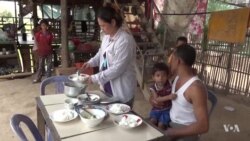Just months ahead of local elections, the Cambodian government has ordered the microfinance industry to cap interest rates on new and refinanced loans at 18 percent a year starting April 1.
Unless she refinances, that probably won’t matter to 32-year-old garment worker In Sokai, given that she took out her four-year loan just a few months ago.
“I borrowed $5,000 and I bought chickens, built the house, and my husband bought a boat, fishing nets and other items,” she said of her loan, for which she is paying 22 percent a year interest.
By Cambodian microfinance industry (MFI) standards, Sokai’s loan is relatively large: 70 percent of MFI customers take out loans under $500. Those loans are typically for less than a year, and they attract a higher interest rate – 30 percent or more – because smaller loans cost relatively more to administer.
That cost has not put off demand for credit, which has driven the microfinance industry’s growth in this country of 15 million people: by 2015, there were 1.5 million depositors and more than 2 million borrowers, with MFIs in every province. Almost all of the loans go to people living outside Phnom Penh and most borrowers are women.
And although new borrowers will surely rejoice at the government’s announcement, the microfinance industry will not. Indeed, the decision to implement the cap – which comes ahead of local elections this year and a national ballot in mid-2018 – caught the industry by surprise.
Yet the timing is politically logical. Borrowers like Sakai often use their land or home as collateral, which means they risk losing it if they default. Additionally, many people believe MFIs are the government, in part because some village chiefs – all of whom are appointed by the ruling party – act as agents for MFIs.
And with land-grabbing a deeply sensitive issue and local elections looming, the government has rushed to change that perception. Some MFIs were ordered to change their logos to distinguish them from that of the Ministry of Economy and Finance; and a nationwide campaign saw every phone call preceded by an audio message telling the caller that MFIs are private entities, not public.
WATCH: One woman's microfinance story
If the cap fits
Interest rate caps are nothing new. More than 60 of the World Bank’s 152 member nations have them because in theory they protect consumers from high interest rates, increase access to finance and make loans more affordable.
But in practice they can have the opposite effect, said Stephen Higgins of the advisory firm Mekong Strategic Partners.
“Ideally we shouldn’t have this cap,” he said. “The interest rates in Cambodia for these small loans, they’re actually among the lowest in the world. And people forget that.”
Higgins says high costs mean MFIs need to charge around 30 percent for a $500 loan repayable over nine months. That may seem like a lot but it amounts to $120, from which the MFI has to fund the capital used and administer the loan. That leaves a modest 4 percent return.
Capping the interest rate at 18 percent means MFIs will lose money from small loans, which comprise around $1 billion of the total $3 billion loan portfolio. The result, he says, is that many MFIs will simply stop offering small loans; rural areas will miss out on $1 billion a year, and people will be forced to turn to moneylenders who charge far more than MFIs.
“Farmers will struggle to get finance to purchase seeds and fertilizer, small businesses will find it hard to get finance to stock their shelves if they’re a small store, for example,” Higgins said. “So you’re going to have some sort of downturn in these rural communities.”
For their part, MFIs face a stark choice: find ways to charge higher fees or close. One of the biggest – Prasac – is looking to become a commercial bank.
The Cambodia Microfinance Association (CMA) put on a brave face at a news conference in Phnom Penh on Thursday, saying its members would need to cut costs and improve efficiencies in order to survive.
Delay timetable
CMA chairman Hout Ieng Tong said negotiations meant the central bank was considering cutting fees for MFIs and would delay its timetable for firms to meet reserve and capital requirements. He also insisted at least some CMA members would still offer small loans.
Mey Kalyan, an economist and an adviser to the government, said there has long been discussion about capping interest rates. Kalyan supports the decision in part because it should prevent smallholders in rural areas from sinking into agriculture-related debt – an area in which a return of 15 percent would be considered high. Borrowing at 30 percent for that sort of return, he says, means a net loss.
And, he noted, the microfinance sector is a small part of the financial system.
“Of course every policy, once implemented, there is some adjustment, some pro and con about this, but overall I think, in the long term, it is for sustainability of the financial system, which is extremely important nowadays because we know very well when financial systems hit, economic system will be hit as well,” he said.
One unknown is whether the decision will spark a run on one or more of the seven deposit-taking MFIs, which have 90 percent of the MFI market. The CMA’s board members said Thursday they were not concerned about that.
Kalyan agreed the risk is small, but said it does reinforce the need for a much-discussed deposit insurance scheme to guarantee most depositors’ bank balances.
The irony of the government’s decision is that, according to the central bank, most borrowers were satisfied with the existing system and most made a profit from their loans – not least because MFIs charge much less than moneylenders. Looking ahead, consolidation in the microfinance industry seems certain; less clear is whether the rural poor will still be able to borrow small loans at reasonable rates.
Khan Sokummono contributed to this report.










